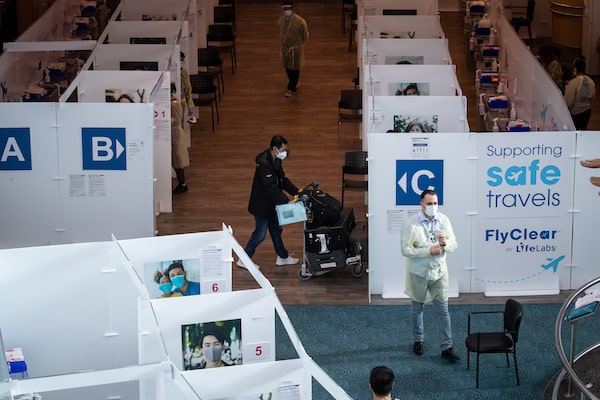
A traveller stops to be tested for COVID-19 at Vancouver International Airport on Dec. 2, 2021.DARRYL DYCK/The Canadian Press
Canada’s Chief Public Health Officer cast some doubt on the continued value of the government’s mandatory on-arrival COVID-19 testing policy for international air travellers. At the same time, business groups called for the policy to end.
Since November, the federal government has been ramping up testing of fully vaccinated international air travellers after they land at Canadian airports. The on-arrival testing is in addition to the prearrival testing that Canada requires of most people entering the country by air, land or sea.
The policy was rolled out to slow the spread of the Omicron variant of COVID-19. But the new version of the virus has now ripped through Canada, on-arrival test positivity is very low and the capacity of labs to process test samples has collapsed under the weight of domestic demand.
The policy is meant to apply universally to air travellers coming to Canada from outside of the U.S. But a strain on testing resources, including lab capacity, has prevented the government from testing as widely as intended.
The Canadian Tourism Roundtable, a coalition of groups that include the Chamber of Commerce and the Tourism Industry Association of Canada, called on Friday for the rule to be scrapped.
In its statement, the roundtable said a halt to “double testing” at the border would free up needed resources. Over the holidays, provinces dramatically slashed access to testing for many people in order to ease the pressure on labs.
“On-arrival COVID-19 PCR tests waste valuable, scarce testing resources that could be redeployed to protect our frontline workers and support a return to school for children,” the roundtable said.
The group found a possible ally in Chief Public Health Officer Theresa Tam.
“Tracking every case isn’t really necessary for a surveillance perspective,” Dr. Tam said at her Friday news conference. “When the whole world has Omicron, our next-door neighbour has Omicron – for the most part, you’re right in that we could do sampling for the tests instead of testing maybe every single vaccinated individual.”
Dr. Tam said the on-arrival testing policy will be evaluated “over time.”
“It is a capacity drain on the system as a whole,” she added.
Still, she said, the policy is important because it can help the Public Health Agency of Canada monitor for new variants – though she added that could also be done through a “really good random sample.”
The NDP said in a statement that the government needs to explain how the border testing policies work to stop the spread of new variants. A statement from the Conservatives said the government’s COVID-19 Testing and Screening Expert Advisory Panel should provide updated advice.
Health Minister Jean-Yves Duclos’s office did not reply to a request for comment on Friday.
On social media this week, several doctors questioned the need for on-arrival testing. Among them was Zain Chagla, an infectious diseases physician at St. Joseph’s Healthcare in Hamilton, Ont.
“Vaccinated people getting asymptomatic testing over the border is pouring water on the dry grass when the house behind you is on fire,” Dr. Chagla wrote on Thursday. “Canada needs to drop travel testing, and focus on local testing. Period.”
The federal government’s data show that between Nov. 28 and Dec. 25, on-arrival tests had an average positivity rate of 1.08 per cent among fully vaccinated air travellers. The rate climbed in the week before Christmas – the most recent period for which data are available – when vaccinated travellers had a test positivity rate of 2.18 per cent. Even the higher number is dramatically lower than the positivity numbers reported domestically.
In the last weeks of December and in early January, the average test positivity rate in Canada was more than 20 per cent. It peaked just below 30 per cent.
The air travel testing rules require passengers to get molecular COVID-19 tests within 72 hours of their scheduled flight departures. If a passenger is arriving from outside the U.S., they are likely to be subject to the on-arrival testing rule. If they are required to take a test when they land, they must isolate until they receive a negative result, or for 14 days – whichever comes first.
Beth Potter, president of the Tourism Industry Association of Canada, said the government tests are taking more than the three-day service standard to return results. The testing, she said, is causing significant numbers of people to cancel travel to Canada, because they risk spending their vacations in isolation.
She said the roundtable sent a request to the government to lift the on-arrival testing requirement more than a week ago, but has received no formal response.
Perrin Beatty, president of the Canadian Chamber of Commerce, said rising case counts and the resulting pressure on hospitals are coming from community transmission, not international travel.
“The next 100 people who walk into your local post office are more likely to be infected than the next 100 people who get off an international flight,” he said.
 Marieke Walsh
Marieke Walsh